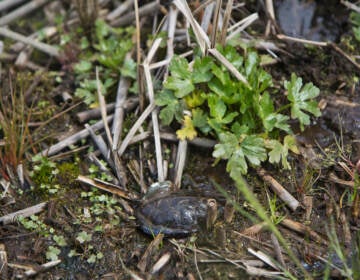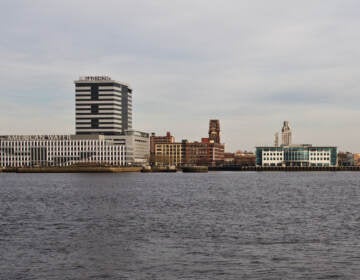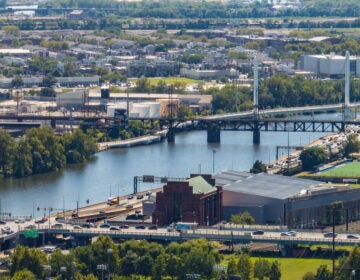Under the full moon on a Delaware beach, volunteers tally horseshoe crabs during their annual mating ritual
Delaware’s Center for the Inland Bays brings volunteers each spring to count, catch, and tag horseshoe crabs, in order to track their population levels.
Listen 3:55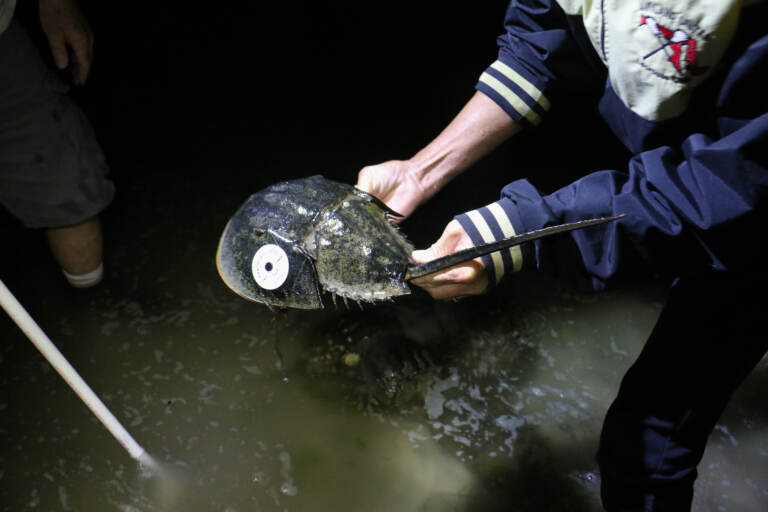
Volunteer Karen Longo holds a tagged horseshoe crab during a population survey at James Farm Eclological Preserve in Ocean View, Del. (Emma Lee/WHYY)
On a June night, a pair of guides led volunteers through the pitch-black woods at a preserve near Delaware’s Bethany Beach — the trail only visible with light from their helmet torches.
The group reached the other side of the trees and arrived at a beach along the Indian River Inlet. The tide was high and the full moon shone brightly in the sky, the perfect conditions for their mission: counting horseshoe crabs.

For more than 400 million years, horseshoe crabs (which are more closely related to spiders than crustaceans) have spawned at the full and new moon-high tides, predominantly in the late spring. Pre-dating the dinosaurs, they’re often called living fossils.
Decades after horseshoe crabs’ dramatic decline, Delaware conservationists hope to secure their survival for years to come.
As the horseshoe crabs, with their helmet-shaped shells and long tails, glided gracefully across the water, the volunteers felt their way up and down the beach — in rain boots or bare feet. They called out counts of males and females, many of which were preoccupied with their annual mating ritual.
“Oh, it’s neat. I love it. It’s fun,” said first-time volunteer Amy Seaman of Annapolis, Md., who runs a “Save the Horseshoe Crabs” Facebook page. “Just seeing them all copulating in the water all together like this. I’ve never seen this many all at once.”
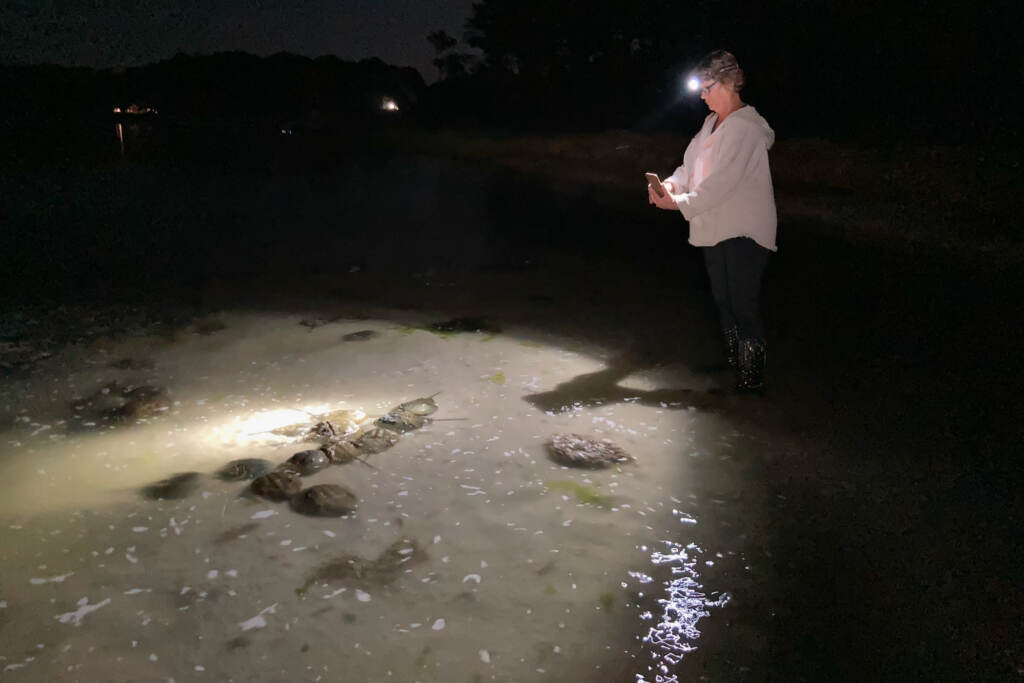
Seaman and the rest of the night-time crew were part of a volunteer program that the Delaware Center for the Inland Bays has hosted each spring since 2008 — attracting about a hundred volunteers a year. Their goal: To count, catch, and tag the horseshoes, in order to track their population levels.
“Horseshoe crabs are difficult to not like. They are very charismatic. They really are interesting,” said Nivette Pérez-Pérez, community science manager for the Delaware Center for the Inland Bays.
More importantly, horseshoe crabs play a crucial role in the watershed ecosystem. Their eggs serve as a food source for dozens of species, including the endangered red knot bird — which relies on the eggs for replenishment during their yearly stopover from South America to the Arctic, where they eventually land and mate.
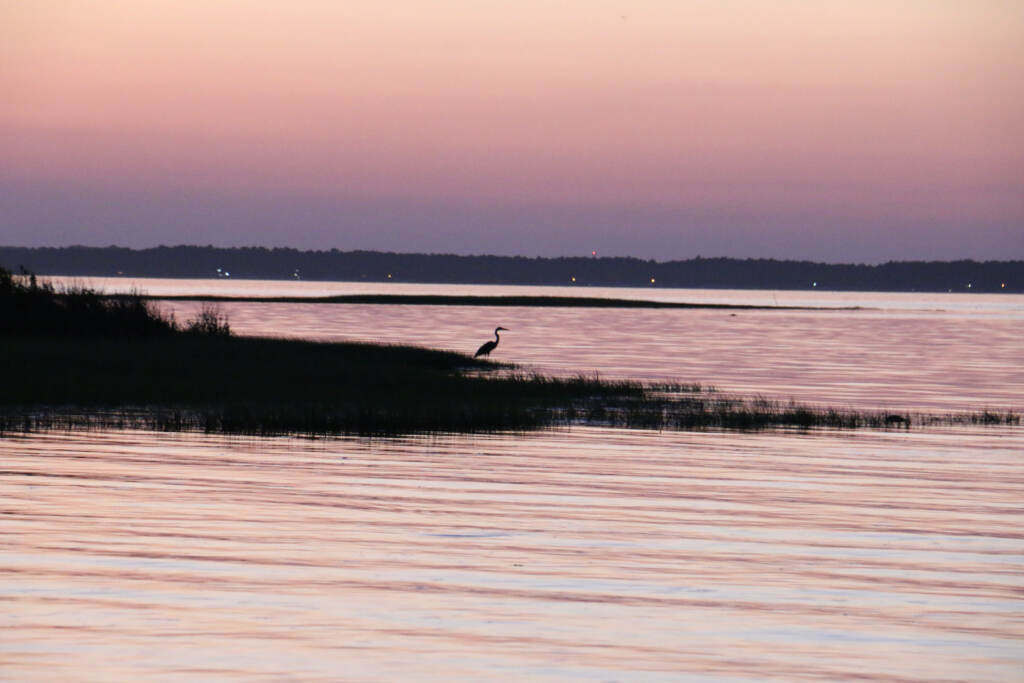
A living fossil under threat
Conservationists like Pérez-Pérez have reason to worry: The red knot population fell 75% from the 1980s to the 2000s, according to the U.S. Fish & Wildlife Service. That’s largely because of a declining supply of horseshoe crab eggs, conservationists say.
In the 1990s, horseshoe crab populations reached devastating low levels, because fishermen used them as bait to catch eel, whelk and conch.
Since then, there have been efforts to limit the numbers of horseshoe crabs that are allowed to be harvested. The Atlantic States Marine Fisheries Commission, which coordinates the conservation and management of fish species on the Atlantic Coast, sets quotas for the amount of horseshoe crabs that can be harvested for bait. That effort has helped steady horseshoe crab and red knot populations to some degree, but their numbers still are nowhere near historic levels.
Horseshoe crabs are also harvested for biomedical research. Their bright blue blood contains a compound used by medical researchers to test the sterility of injectable drugs, biomedical devices and vaccines. Their blood also aided in the development of the COVID-19 vaccine.
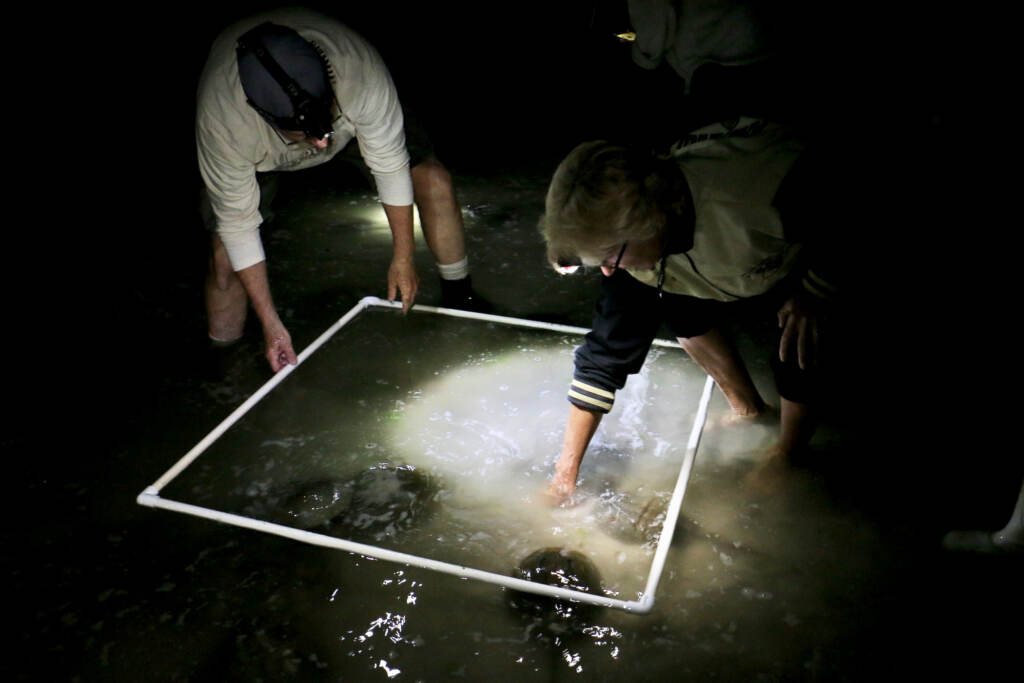
Though horseshoe crabs are returned to the water after being bled by lab technicians, it is believed 15 to 30% that are used for biomedical purposes eventually die. It is estimated that about 500,000 crabs are harvested along the Atlantic coast for biomedical use. The Atlantic States Marine Fisheries Commission does not issue quotas for this purpose.
Horseshoe crab harvesting regulations vary from state to state: New Jersey has a moratorium on horseshoe crab harvesting, but has an exemption for biomedical use. Delaware does not have a moratorium on harvesting for bait, but bans harvesting for biomedical purposes.
Horseshoe crabs are also threatened by development, pollution, and climate change. All of these threats combined highlights the importance of surveying work, said Dennis Bartow, a senior naturalist for the Delaware Center for the Inland Bays.
“I’d like to see them continue through the sixth mass extinction, which might include ourselves,” he said. “And with climate change, our environment is changing, our sea level is rising, it’s going to submerge our beaches, flood our marshes, and their habitat is going to disappear. So, we need to be aware of their population.”

Bartow and other conservationists have advocated for the use of man-made horseshoe crab blood, which has been developed. However, its use has not been considered in the U.S.
Bartow also believes using artificial bait would benefit horseshoe crab populations. Other conservationists say artificial bait doesn’t work as well, but that clam-based bait could be used.
Population levels are up for debate
Earlier this year, the Atlantic States Marine Fisheries Commission approved a revised algorithm for analyzing wildlife in order to guide harvesting quotas. Proponents argue the new model provides a much more accurate picture of horseshoe crab and red knot populations.
However, the calculations could lead to female horseshoe crabs being added to the harvesting quota for the first time, as early as next year. Previously, female horseshoe crabs weren’t included in the quota. Several conservationists argue that harvesting females would have devastating impacts on red knots.
The U.S. Geological Survey estimates that 40,000 to 50,000 red knots stop and feed each spring along the Delaware Bay. However, Larry Niles, a biologist formerly with the New Jersey’s Fish and Wildlife division, argues those numbers are flawed because it includes red knots that fly overhead, rather than solely birds feeding on the beach.
“They’re flying over looking for other places that they may not find, which means they won’t breed,” Niles said.
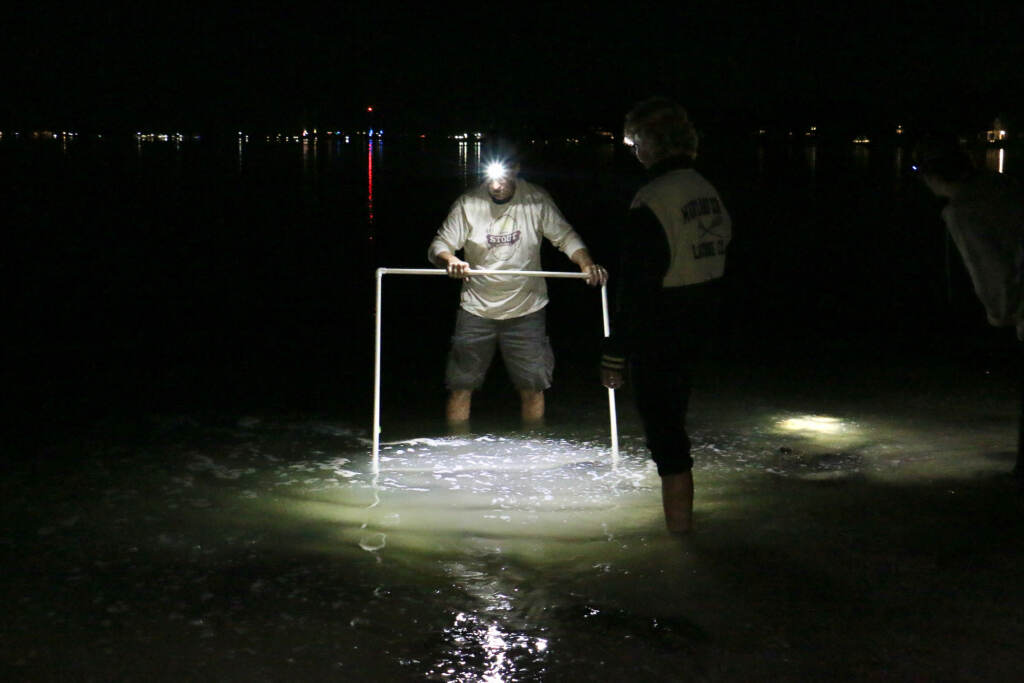
He and his colleagues with the Delaware Bay Shorebird Project, which has assessed shorebird numbers in the region for 26 years, report that red knots remained at historically low levels in 2022. Though numbers increased from 6,800 in 2021 to more than 12,000 this year, it’s less than half the 2019 peak count of 30,000 — and a fraction of the peak population of more than 94,000 in 1989.
The Atlantic States Marine Fisheries Commission reports that Delaware Bay horseshoe crab populations have steadily increased over the last decade to an estimated 31.3 million crabs, comprising 21.9 million males and 9.4 million females.
Niles argues that egg density is a more important figure to take into account. According to the Delaware Bay Shorebird Project, horseshoe crab egg density in Delaware Bay was about 7,000 eggs per square meter in May 2022. In the 1990s, eggs reached nearly 50,000 per square meter.
“Now they’ve cut the population of crabs down to the point where there’s good eggs only for a week or two. And then if it falls outside of the time when the birds are here, then the birds are screwed,” Niles said.
Preserving horseshoe crabs ‘for generations to come’
It was nearing midnight when the Center for the Inland Bays’ volunteers finished their count of horseshoe crabs. They placed the wriggling creatures in a kiddie pool, so that they could be tagged one-by-one.
Bartow determined their sex and age to learn more about population health (females are important for reproduction, and age determines if they’re past their reproductive cycle). He also tagged them so that the Center can follow their movements.
“Now, this is a young male,” Bartow said as he sat in a beach chair. “He will not complain when I drill, but you might see some blood.”
After the horseshoe crabs were tagged, volunteers released them back to their homes and made their way back to the other side of the woods with a feeling of pride. Pérez-Pérez said she hopes their work will pay off.

“A success for us is that we can preserve the horseshoe crabs that are here for generations and generations to come, and that we can see them come back every year,” she said.
WHYY is your source for fact-based, in-depth journalism and information. As a nonprofit organization, we rely on financial support from readers like you. Please give today.



